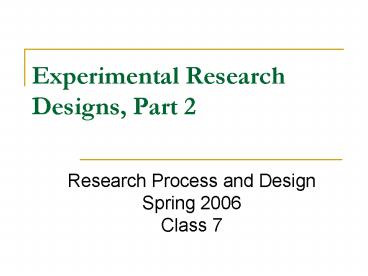Experimental Research Designs, Part 2 - PowerPoint PPT Presentation
1 / 19
Title:
Experimental Research Designs, Part 2
Description:
Experimental Research Designs, Part 2 Research Process and Design Spring 2006 Class 7 Today s objectives To answer any questions you have To further explore quasi ... – PowerPoint PPT presentation
Number of Views:287
Avg rating:3.0/5.0
Title: Experimental Research Designs, Part 2
1
Experimental Research Designs, Part 2
- Research Process and Design
- Spring 2006
- Class 7
2
Todays objectives
- To answer any questions you have
- To further explore quasi-experimental and
single-subject designs - To talk about writing the methods section
- To apply knowledge to your group project
3
Characteristics of Experimental Research
- Statistical equivalence of subject in different
groups (usually by random assignment) - Comparison of 2 or more groups
- Manipulation of at least 1 IV
- Measurement of DVs
- Inferential statistics
- Maximum control of extraneous variables
4
Experimental ResearchStrengths and Limitations
- Strengths
- The only designs capable of examining causal
relationships - High degree of control of extraneous variables
- Direct manipulation of an independent variable
- Weaknesses
- High levels of control needed for assuring
internal validity mean very restrictive
manipulated conditions which in turn imply low
external validity - High levels of external validity mean little
control and thus low internal validity - Not possible in many situations
5
Quasi-Experimental Designs
- Good designs that are frequently used in
education - Lack of control related to randomly assigning
subjects to groups (i.e., the use of pre-existing
groups) - Non-equivalent groups terminology reflects the
lack of random assignment and the concern about
the selection internal validity threat
6
Quasi-Experimental Designs
- Basic designs and several variations of them
- Non-equivalent groups designs
- Non-equivalent groups pretest-posttest
experimental-control - Non-equivalent groups pretest-posttest
experimental-comparison - Non-equivalent groups pretest-posttest
experimental-control-comparison - Statistical analyses focus on the comparison of
groups and the use of appropriate analyses like
ANCOVA
7
Quasi-Experimental Designs
- Time series designs groups repeatedly measured
before and after treatments - Single group interrupted time series (e.g., A
OOOOOO X OOOOOOO) - Experimental-control group interrupted time
series - Variations of these designs include the use of
comparison groups and different treatment times - Statistical analyses examine the patterns of
performance over time
8
Factorial Designs - Definitions
- Main effect the effect of each independent
variable on the dependent variable - Interaction effect the effect of the
interaction of two or more independent variables
on the dependent variable - Factors independent variables (e.g., two-factor
design means two independent variables being
studied) - Levels independent variables vary, often
represented in groups (e.g., high, medium, low)
9
How many variables? How many IVs? How many groups?
- 2 x 2
- 3 x 2
- 3 x 2 x 2
- 2 x 2 x 2 x 2
10
Single-Subject Designs
- The use of one subject studied over time
- Typically one subject, but there are situations
where two or three subjects are sampled - Focus on populations where there is a low
incidence of specific characteristics (e.g.,
severe and profound special education students,
physically-challenged students, etc.) - Need to draw causal inferences
11
Characteristics of Single-Subject Designs
- Reliable measurement
- Repeated measurement
- Explicit descriptions of conditions
- Baseline and treatment condition duration and
stability - Manipulation of a single variable at one time
12
Single-Subject Designs
- Three types of designs
- A-B designs baseline and treatment
- A-B-A or A-B-A-B designs baseline, treatment,
baseline (i.e., reversal or withdraw designs) - Multiple baseline designs
13
Single-Subject DesignsMultiple Baseline
- Use of the A-B logic with the addition of two or
more actions, subjects, or situations - Used when it is impossible or undesirable to
remove a treatment condition - Types
- Multiple baselines across behaviors (i.e., the
use of a single treatment across several distinct
behaviors) - Multiple baselines across situations (i.e.,
observation of a single target behavior observed
in two or more settings) - Multiple baselines across individuals (i.e., two
or more subjects receiving treatment where
behavior and the situation are held constant) - Statistical analyses examine the patterns of
behavior
14
Group Activity
- Design a study using 2 of the research designs
described in todays or last weeks class. - What are the implications of each design?
- What are the pros and cons of each design?
15
The method section of a quantitative study
- Vary somewhat but generally have the following
components - Participants
- Variables
- Instrumentation/materials
- Procedures
- Data analysis
16
More specifically, methods section should
- Identify research design
- Describe sample, population, and participants
- Describe instruments, variables, and materials
- Review procedures in detail
- Explain plans for preliminary studies or pilot
studies (if necessary) - Provide details about data analysis procedures
- Identify ethical issues and your approach to
dealing with them - Describe limitations or threats to validity
17
- Remember, you need to give enough information so
that the study can be replicated
18
Group project
- Begin thinking about the elements of your method
section - What design will you employ?
- Who do you plan to study?
- What and how will you collect data?
- What are your independent and dependent variables?
19
For next week
- Non-experimental research design Correlational
and ex post facto studies - Readings
- Jaeger Chapter 4 (p. 61-76)
- Wiersma, W. Jurs, S. G. Chapter 7
- Distribute take-home exam
- Reminder Outline of literature review due































